|
Passage to Yafa’ (1891–1967)
All but one of the photographs illustrating this article were taken by Lieut-Colonel M. C. Lake (or with his camera) in November 1925, and are published here by kind permission of The National Archives, Kew.
| |
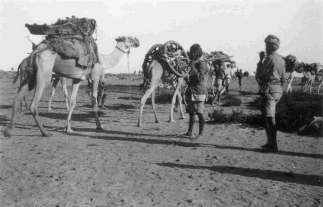
|
| |
|
Cannon requested by Sultan
Aidrous bin Muhsin being
transported on camelback to Lower Yafa’. |
| |
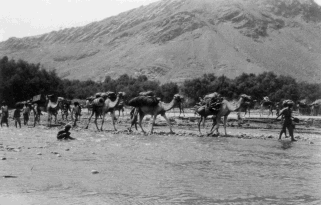 |
| |
| Colonel Lake’s
caravan crossing Wadi Bana. |
Throughout the period of British rule in South West Arabia, the highlands of Yafa’ were closed to all but a handful of European visitors. The Yafa’is were a confederation of hardy, warlike tribes who, although weakened by internal dissension, tended to close ranks in guarding their independence against any threat of foreign intrusion. Many Yafa’is travelled abroad to earn a living as mercenaries in the armies of Arab and Asian potentates: Hadhramaut, whose ruling Qu’aiti dynasty were of Yafa’i origin, being historically the principal focus of Yafa’i migration. But contact with the outside world did not diminish the Yafa’i people’s distaste for any interference in their internal affairs.
This reality was scarcely reflected on paper, for Yafa’was officially part of Britain’s Aden Protectorate and neatly divided into two sultanates. The British had signed a treaty of Protection with the Lower Yafa’Sultan in 1895, and one with the Upper Yafa’Sultan in 1903; but they also paid subsidies to a number of Upper Yafa’tribal chiefs, in tacit recognition that the latter had as much if not more influence than their titular Sultan. So power in Yafa’ was fragmented, and ebbed and flowed according to the personality and economic means of local tribal leaders. Of the two Sultans, only the Sultan of Lower Yafa’ was in a position to exert significant influence beyond his own clan, the Bani ‘Afif. Claiming descent from a line of pre- Islamic priest-kings, the Sultan was the hereditary keeper of a drum said to embody the spirit of the Yafa’is’ancient tribal god, and he was also credited with powers of rain-making. These attributes conferred a mystique which underpinned his ability to act as mediator in local disputes. Mediation was, in fact, his primary role. There was no tradition in Yafa’, or elsewhere in the region, of a Sultan exercising executive power; in Lower Yafa’ he exerted influence through judicious present- giving and hospitality; all visiting notables expected to be tipped and fed by him, while unruly tribesmen had to be bribed to keep the peace. The Lower Yafa’ Sultan’s income from customary tithes and from his family’s extensive agricultural lands enabled him to bear the considerable expense of maintaining little more than a tenuous authority.
The highlands of Lower Yafa’rise above the northern Abyan plain, some twenty miles from the sea. Skirted by Wadi Bana to the west and by Wadi Hassan to the south, they stretch northwards into the mountains of Upper Yafa’ to a height of some
8,000 feet. Lower Yafa’ had two capitals: al-Husn in the lowland plain, and al-Qara, the Sultan’s mountain retreat several days’ march north of al-Husn.
In 1891/92 Captain R. A. Wahab RE, from the Survey of India, undertook a geographical study of ‘all territory having political relations with the Aden Residency within a radius of seventy miles’. However, Wahab was only able to include the lowland fringe of Yafa’in his survey ‘owing’, as Brigadier-General John Jopp, the British Resident in Aden, reported to Bombay, ‘to some misunderstanding between the newly elected Yafi’i Sultan and the detached survey party’. It seems fair to speculate that this ‘misunderstanding’ arose from the price demanded by the Yafa’is for permitting the party to travel inland. A few years later the ambition of Theodore and Mabel Bent to visit al-Qara foundered on the extortionate demands (as the Bents considered) made by the then Sultan for granting them access to his highland capital.
| |
 |
| |
|
Sultan Ali Abdullah with
Yafa’i tribal guards who
escorted Colonel Lake from al-Husn to al-Qara. |
In 1902 R. A. Wahab (now Colonel) returned to Aden to head the British side of the Anglo-Turkish Boundary Commission which had been charged with delimiting the disputed frontier between Ottoman Yemen and the Aden Protectorate. Wahab’s hopes of including Upper Yafa’in this exercise were also frustrated. But in 1904 he did succeed in sending a survey team into Sha’ibi territory (which, although lying west of Wadi Bana, was initially lumped by the British with Upper Yafa’). The team’s military escort, while encamped at Awabil, the Sha’ibi capital, was attacked by the Sultan of Upper Yafa’, Salih bin Omar, who had recently ousted his brother, Qahtan, and was said to be under Turkish influence. Salih’s attack was soon repulsed and he was forced to retreat eastwards across Wadi Bana to his ancestral fastness at al-Mahjaba.
The first European to visit Lower and Upper Yafa’ was Lieut-Colonel M. C. Lake in November 1925. Seconded to Aden from the Indian Army during the First World War, Lake (1886–1943) raised and trained a tribal force for local guard duties, curiously named the First Yemen Infantry. Following its disbandment in 1924, Lake was given the more fulfilling task of establishing and commanding the Aden Protectorate Levies (APL). In the 1930s he transferred to Aden’s political staff, serving as Protectorate Secretary (and later as acting Resident and Governor) until his retirement in 1940.
An austere and generally reserved man (except in Arab company), Lake enjoyed travelling in unexplored parts of the hinterland and relished the opportunity to visit Yafa’. The opportunity arose because the Yafa’is feared that the Imam of Yemen’s forces, which had already occupied swathes of territory inside the Protectorate to the west and east of Yafa’ (in Dhala’/Sha’ib and on the Audhali plateau), might be tempted to encroach upon their own lands. They wanted the RAF to undertake a flag-waving exercise to deter the Zaidis (as they were wont to call the Yemenis) from advancing south. In an unusual spate of correspondence between the British Resident inAden andYafa’i chiefs, the former pointed out that a necessary precondition of arranging an overflight would be to identify and prepare suitable landing grounds; to this end he would need to send a mission toYafa’, for which tribal escorts and assurances of safe passage would be required. In a rare display of inter-tribal harmony, and swallowing for the moment their notorious distrust of foreigners, the Yafa’is accepted these terms. Meanwhile, the Sultan of LowerYafa’, Aidrous bin Muhsin, a young man in his mid-twenties who had just succeeded his deceased father, asked to be supplied with a cannon to defend al- Qara. The Resident undertook to send him a ten-pounder, and in due course this, having been dismantled into its component parts, was loaded onto camels for onward delivery. Such, then, was the background to Colonel Lake’s journey to Yafa’.
| |
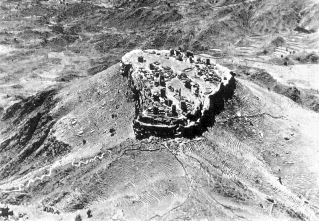 |
| |
|
Aerial view of al-Qara
c.1950.The minaret near the
centre was built after Lake’s visit in 1925. |
| |
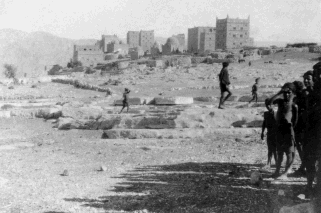 |
| |
|
View of al-Qara taken by
Lake.The town’s four-domed
rectangular mosque and three (domed) shrines
lie in front and to the side of the tower houses in
the background. |
Lake was accompanied by Pilot Officer H. Walker, Muhammad Salim, a Residency interpreter who also acted as Lake’s political assistant, and, from al-Husn onwards, by an escort of Yafa’i tribal guards led by Sultan Ali bin Abdulla. Lake also took with him 10, 000 rupees in two steel trunks to distribute as douceurs to tribal chiefs, and to cover hospitality expenses and payments to camelmen. Ten days after leaving Aden Lake’s party arrived in al-Qara to a gratifyingly warm welcome.
Lake’s account of the journey includes a vivid description of local topography:
‘Al-Qara stands on a hill rising almost straight up out of the surrounding valleys to a height above them of about 800ft and is approached from below by a winding stony path. . . A wonderful panorama is disclosed from the top. . . To the south one looks acrossWadiAm Hadara to Jebel Maufaja, from the [summit] of which Jebel Shamsan and Aden harbour can be viewed on a clear day. To the west, far away in the distance, one can see the Radfan range, and beyond that, a little further west, the Amiri country with Jebel Dhubiyat. West-north-west, the lofty ridges of Muflahi territory stand out in all their rugged nakedness, and further north lies JebelAhlYazid, crowned all along with stone dars silhouetted against the sky and beyond which lie the ranges of Upper Yafa’ …A little to the east of north may be seen the range of Jebel al-Ur, which we were refused permission to visit and so still remains untrodden by a European, with Nasaba Kasad to its east standing out like a hump in a camel’s back… East-north-east and far in the distance the wall of mountains ends abruptly in a steep drop down on to the Kaur and the plains of Dathina… To the east and south-east the view becomes more restricted, being cut short by the slopes of Jebel ash-Shaab and the hills to the south of Wadi Sarrar. The intervening country all round consists of a series of ridges and valleys, the ridges terraced for the cultivation of dukhn [sorghum], and the valleys green with coffee plantations and wheat and barley. It is a view not easily forgotten, and of its kind, in its wild grandeur, must be one of the most magnificent in all Arabia, more especially in the early morning and the evening with the wonderful changes of light and shadow. ’
| |
 |
| |
|
Al-Qara. Colonel Lake with
the Lower Yafa’ Sultan,
Aidrous bin Muhsin (centre), and
Muhammad Salim, Residency interpreter. |
During his two and a half week sojourn at al-Qara, Lake managed to organise some training in the use and maintenance of the now re-assembled cannon. ‘It was quite time’, he wrote to the Assistant Resident, Bernard Reilly, ‘as the gun was full of sand from the journey up, and that, mixed with the oil and grease from the [Aden] arsenal, made it quite unworkable. . . I have also explained to Aidrous what it costs to fire off a single shell. . . ’Aidrous promptly asked for a free gift of 400 shells! Lake was accompanied everywhere by the young Sultan, even to Hanakat al- Marshad on the border with Upper Yafa’. There the chiefs of Upper Yafa’, having temporarily put aside their differences, had gathered to welcome Lake. The old Muflahi Shaikh, Abdulrahman, was represented by his son, but the titular Sultan of Upper Yafa’, Salih bin Omar al-Harhara, who had attacked the British survey party’s escort at Awabil in 1904, stayed away and his attitude to Lake’s visit was to prove somewhat disobliging. Lake formed the impression that Salih bin Omar had little authority outside his fort in al-Mahjaba, and that the chiefs who exerted most influence in Upper Yafa’ were the Naqibs of Mausatta. Lake’s tour of the region included Lab’us, Qudma, Jurba, Masjid al-Nur, and Bani Baq; the latter, with its 200 dars, being ‘the largest town in the whole of Yafa’’. The coffee plantations in Wadi Hatib were the finest Lake had seen. He climbed Jebel al-Shibr from where he had a view of the Yemeni borderland. He was accompanied back to Lower Yafa’ by the Dhubi Shaikh of Di Sura, Salim bin Salih, and Muhammad Ali Askar, one of the five Naqibs of Mausatta, whose father, Ali Muhsin Askar, featured in Wyman Bury’s book, The Land of Uz (1911).
Al-Qara’s next European visitor was Sir Stewart Symes in 1929. Symes, who was Resident in Aden between 1928 and 1931, reported that he was ‘very hospitably entertained’. This was doubtless because he brought news of the increased stipend which Sultan Aidrous had requested during Lake’s visit in 1925. Symes was followed in 1938 by Stewart Perowne, a political officer whose purpose in visiting is unclear; but it seems likely that he was sent to wave the Imperial British flag at a time of increasing international tension.
| |
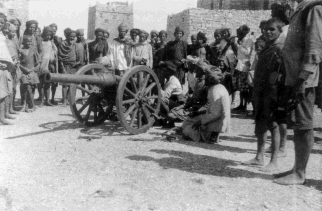 |
| |
| Al-Qara. Servicing the
re-assembled cannon. |
| |
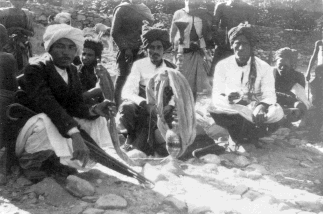 |
| |
|
Sultan Aidrous bin Muhsin
(centre) with the Dhubi
Shaikh of Di Sura, Salim bin Salih (right), and
Muhammad Salim (left) at Hanakat al-Marshad on
the border between Lower and Upper Yafa’. |
It was not until 1950 that Sultan Aidrous received his next European visitor. This was Malcolm Milne (d. 2006) who had a brief tour of duty in Aden (1950–51) before resuming his Colonial Service career in West Africa. As Senior Political Officer based in Zinjibar (in the southern Fadhli segment of the Abyan delta), Milne’s responsibilities included the lowland fringe of LowerYafa’ – the only part ofYafa’open to the British – where SultanAidrous’authority centred on al-Husn and Ja’ar. Milne was sent to al-Qara to settle outstanding claims to ‘blood money’ lodged against the Protectorate authorities by theYafa’i tribe of Bani Qasid. Milne took with him a box of freshly minted MariaTheresa dollars to distribute, through Sultan Aidrous, to the ‘blood money’ claimants. Milne includes a spirited account of his journey to al-Qara in his autobiography, No telephone to Heaven (1999). Of his arrival he wrote:
‘Rounding a low hill we saw the citadel of al-Qara 1, 500 feet above us, the fortified dars white against the sky beyond. The twisting, mile-long path to the citadel was black with tribesmen. Hassan Muhsin [a lowland notable] estimated that three thousand armed men awaited us. . . The Sultan himself, surrounded by a party of retainers brandishing swords, came slowly down the path to greet us. Tribesmen, bare chests rubbed with indigo and oil of sesame, pressed forward. As the parties met the saluting began: a cannon from the heights above fired twelve times, every tribesman lining the route [discharged his rifle] from the hip as they approached. . . That night the skies opened and the rain fell amid crash after crash of thunder. . . ’
| |
 |
| |
|
Upper Yafa’. Shaikh
Abdulraham, the Muflahi chief,
with (on his left) his son, and (to his far right) his nephew. |
Milne’s visit foreshadowed that of the Governor of Aden, Sir Tom Hickinbotham, in 1952. 1n his memoirs (Aden, 1958) Hickinbotham recorded:
‘[al-Qara] is quite the most extraordinary [town] that I have seen anywhere in the world. 1t is built on a circular limestone cap of a very steep hill which looks like a truncated cone, and the town can be reached only by two very rough tracks, up which camels and donkeys can, with difficulty, make their way. I was determined to visit al-Qara partly out of curiosity and partly because I was anxious to increase our influence in even the remote areas of the Protectorate. . . The Sultan. . . had left his eldest son, Sultan Muhammad, to act as our escort. [Muhammad] led the cavalcade on a horse with a motley assortment of tribesmen running at his stirrup, while I followed on my donkey. . . We could see al-Qara gleaming white far above us on its hill- top. . . and on the flat ground immediately below the hill thousands of tribesmen were drawn up in lines awaiting our arrival. Blue kilts, indigo-dyed bodies, bobbed hair, rough leather sandals and the inevitable armoury of rifle, cartridge belt and silver sheathed dagger; they were as splendid as they were unexpected in that wild and seemingly sparsely populated country. Sultan Muhammad and I moved forward on foot to greet the Sultan [Aidrous] who, dressed in a purple plush frockcoat, a blue and yellow striped kilt and a head cloth of the same colours, was busily engaged acting as ringmaster in the midst of this amazing scene. . . All afternoon the mass of tribesmen swarmed through the town, where they were fed by the Sultan, shouting and singing. It was not until nightfall that they dispersed back to their villages in the surrounding mountains. . . ’
Commenting in August 1953 on the visits to Lower Yafa’ by Milne and Hickinbotham, David Treffry, who had been posted to Abyan, and had himself visited al-Qara a few weeks earlier, noted in a secret memorandum:
‘The attitude of the tribes on each [occasion] remained fundamentally antagonistic . . . I have been made aware of the vigour of the opposition to HE’s visit in conversation with [members of his party], with the Lower Yafa’Naib [Sultan Muhammad] who was responsible for his safety, and with the Tribal Guards who provided the escort. . . The unfriendliness of public sentiment on my recent visit was quite unconcealed. My party was insulted by wayfarers met on the road and in the fields. . . Some 1000 armed Kalad tribesmen, seen in Wadi Sarrar, had by their own admission assembled to hold the Maskaba Pass against the invading army that [they had] expected. The coffee plants of the Sultan were cut down by Saadi tribesmen in protest at his pro-government proclivities. . . Their opposition springs from their traditional hostility to government, their fear of change and their passionate independence. . . ’
Treffry added that visits to al-Qara by British officials had only been possible because Sultan Aidrous bin Muhsin had spent heavily on buying off tribal opposition.
| |
 |
| |
|
Upper Yafa’.Three of the
five Naqibs of
Mausatta. Naqib Muhammid Ali Askar is
in the middle. |
Treffry’s visit in June 1953 was the last to be made by a European before independence in 1967. In the intervening years relations between the British and the Sultan deteriorated. This was partly due to Aidrous bin Muhsin’s increasing eccentricities of behaviour, which were thought to be a symptom of insanity brought about by chronic inbreeding. Aidrous eventually went into seclusion, as his father had done before him, leaving his eldest son, Muhammad, to act on his behalf.
Handsome in an austere way, Muhammad bin Aidrous impressed his British mentors with his quiet dignity and enquiring mind, and as Naib of lowland Yafa’ he made a promising start in local administration. But he was to develop a distrust of British intentions, fuelled by Arab nationalist sentiment, which led to a growing estrangement, and in the mid-1950s he decamped to al-Qara. Muhammad then turned to Yemen for support, became the mainspring of Yafa’i dissidence, and was thrust into the title role of demon prince, or national hero, according to ideological viewpoint. Thus it was that in the twilight of British paramountcy, al-Qara became the target of several punitive air strikes aimed at forcing Muhammad to abandon his base in the Yafa’i highlands and move to Yemen.
The only journey into Upper Yafa’by a European since Lake’s tour of the area in 1925 was an unexpected one made in mid-1952 by Nigel Groom who was then serving as Political Officer in Dhala. Drawing largely on long buried memories of that journey, Nigel Groom has kindly recorded the following account:
‘One morning a Tribal Guard arrived with a message from the Naib of Sha’ib that an aeroplane had crash-landed in a wadi in an extremely remote part of Upper Yafa’close to the Sha’ibi and Yemeni borders. This was followed a little later by a similar message from the Muflahi Shaikh and then from the Amir of Dhala, and over the next day or two from several other notables. Their reports were all consistent and plausible. I signalled Aden who confirmed, after contacting Taiz, that no British nor Yemeni aircraft had been reported missing. The RAF undertook a systematic air search but the area in which the crash was reported to have occurred was so wild, mountainous and unmapped that it was hardly surprising that nothing was seen.
I was ordered to go on an urgent search and rescue mission and to take with me a strong enough escort to counter any tribal resistance. My wife, Lorna, who was with me in Dhala at the time, recorded that I departed with 15 Government Guards and about 60 Aden Protectorate Levies (APL) including two medical orderlies with medical supplies and two stretchers. They all came from the garrison in Dhala.
I have little doubt that we started by driving in trucks to Khalla which was as far as vehicles could go on the main route to Awabil. Pack animals were always readily available at Khalla, and we took some thirty camels and donkeys for the baggage – boxes of ammunition, rations etc. We did not go through Awabil, but marched roughly due east of Khalla, climbing down and round the mountain slopes. Eventually we reached the narrow, steep-sided gorge ofWadi Bana. Here theWadi roughly follows a north to south course, providing a boundary between Sha’ib and UpperYafa’. We proceeded north for several miles, and as we went we could hear and sometimes see the search planes. In the very north of Sha’ib, Wadi Bana bends sharply to the west. At precisely this pointWadi Sih, flowing north to south, joins Wadi Bana. Instead of turning left we marched straight on upWadi Sih whose west bank on our left formed the undemarcated boundary with Yemen, with Upper Yafa’ on our right. We were now traveling through the territory of the (five) Naqibs of Mausatta, perhaps the most remote of the Protectorate chiefs.
Wadi Sih was much like the Bana, narrow and twisted, with high cliffs on either side and a perennial stream of water providing shrubs, small trees and grass. But a few miles up the wadi we were brought to a halt by a tumbled mass of huge rocks and boulders, ten to fifteen feet high, which completely blocked the gorge. I was told there was a footpath skirting this obstruction which led up into the Yemeni hills to our west and came back into the wadi a few miles further on. But this diversion was, of course, all in the territory of the Imam, and was, moreover, impassable for baggage camels. My only choice was to leave my APL escort where they were and to go through with my lightly burdened Government Guards. I sent a messenger off with a letter to the Shaikh of the local Yemeni tribe seeking permission to use the path on our mission of mercy. His dar was some miles away to the west, so we did not receive a reply until next morning. Meanwhile, we pitched camp. It was a pleasant spot, with plenty of running water and fodder for the animals, but full of mosquitoes once darkness fell. We had hardly met a soul on the journey; the whole area seemed to be devoid of population.
The Shaikh replied that he would like to help us but there were difficulties which he felt he would need to come and talk over with us first. He did not want to be seen at our camp nor in our company, so the meeting would have to be after dark and he would send one of his men to take me and my entourage to the spot where he would meet us.
The Shaikh, who had three or four armed henchmen with him, said that he would be glad to help us but he had received a message from Taiz warning him that a search party was being sent to the area, and that the Imam had ordered that under no circumstances should any officer or military force from the Protectorate be permitted to pass through Yemeni territory. He dared not disobey such an order. Given the Imam’s propensity for beheading people for the slightest disobedience, I could respect his feelings. We talked for a while and the Shaikh eventually agreed that I could send four Government Guards in civilian clothing through to search the upper part of Wadi Sih for any signs of a crashed aircraft. The Guards left at dawn the next day and returned in the evening having found no physical signs, nor anecdotal evidence from local goatherds, of the reported crash. By this time we were quite satisfied that the whole story was an unfounded rumour, and early next morning we began our journey back to Dhala. We were away on this wild goose chase for about a week. But for me it was an exciting adventure, and at least I can claim to be the only British officer, since Lake’s trip to Upper Yafa’in 1925, to have entered the realm of the Naqibs of Mausatta!’
Editor
Vol
15. 2007
|
